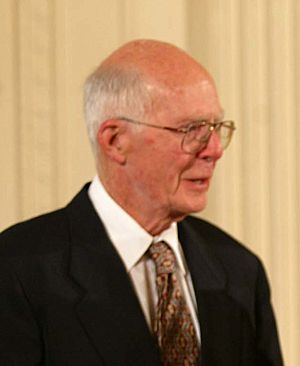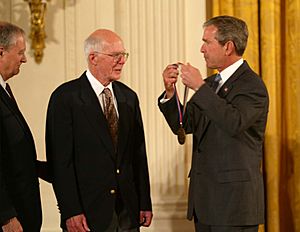Raymond Davis Jr. facts for kids
Quick facts for kids
Raymond Davis Jr.
|
|
|---|---|

Davis in 2001
|
|
| Born | October 14, 1914 |
| Died | May 31, 2006 (aged 91) |
| Nationality | American |
| Alma mater | University of Maryland Yale University |
| Known for | Neutrinos |
| Awards | Comstock Prize in Physics (1978) Tom W. Bonner Prize (1988) Beatrice M. Tinsley Prize (1994) Wolf Prize in Physics (2000) National Medal of Science (2001) Nobel Prize in Physics (2002) Enrico Fermi Award (2003) |
| Scientific career | |
| Fields | Chemistry, physics |
| Institutions | Monsanto University of Pennsylvania |
Raymond "Ray" Davis Jr. (October 14, 1914 – May 31, 2006) was an American chemist and physicist. He is famous for leading the Homestake experiment from the 1960s to the 1980s. This was the first experiment to find neutrinos coming from the Sun. For this important work, he shared the 2002 Nobel Prize in Physics.
Contents
Early Life and School
Ray Davis was born in Washington, D.C.. His father worked as a photographer for the National Bureau of Standards. Ray spent some years singing in a choir to make his mother happy, even though he wasn't a great singer. He liked going to concerts at the Watergate before airplane noise became too loud. His younger brother, Warren, was his best friend growing up.
Ray studied chemistry at the University of Maryland. He earned his bachelor's degree in 1938 and later a master's degree from the same school. In 1942, he received his Ph.D. in physical chemistry from Yale University.
His Career and Discoveries
During World War II, Ray worked at Dugway Proving Ground in Utah. He observed tests of chemical weapons and explored the area around the Great Salt Lake.
After the war, in 1946, Ray started working at Monsanto's Mound Laboratory in Miamisburg, Ohio. There, he focused on radiochemistry, which is about radioactive materials. This work was important to the United States Atomic Energy Commission. In 1948, he joined Brookhaven National Laboratory. This lab was dedicated to finding peaceful uses for nuclear power.
Ray was asked to find something interesting to research. He decided to spend his career studying neutrinos. Neutrinos are tiny particles that scientists thought existed to explain a process called beta decay. However, no one had actually seen them yet.
Ray tried to find neutrinos using a process where a neutrino would hit a nucleus and turn a stable atom into a radioactive one. This process happens very rarely. So, Ray had to make sure that other things weren't creating the same radioactive atoms, which could trick him into thinking he found neutrinos. He used large tanks of carbon tetrachloride (a liquid containing chlorine atoms) as detectors.
He placed his detectors near nuclear reactors. These experiments showed that neutrinos produced in the Sun were different from "antineutrinos" produced in reactors. This was a big step!
The Homestake Experiment
Finding neutrinos proved to be much harder than not finding antineutrinos. Ray Davis became the lead scientist for the Homestake Experiment. This was a huge detector built deep underground in a gold mine in South Dakota. It was designed to find neutrinos coming from the Sun.
The Homestake Experiment was the first to successfully detect evidence of neutrinos from the Sun. This was a major breakthrough in astrophysics, the study of stars and space.
Nobel Prize Recognition
In 2002, Ray Davis shared the Nobel Prize in Physics. He shared it with Japanese physicist Masatoshi Koshiba and Italian Riccardo Giacconi. They were honored for their important work in astrophysics, especially for finding cosmic neutrinos and helping to solve the "solar neutrino problem" with the Homestake Experiment. Ray was 88 years old when he received this prestigious award.
Personal Life
Ray Davis met his wife, Anna Torrey, at Brookhaven. Together, they built a 21-foot wooden sailboat called the Halcyon. They had five children and lived in the same house in Blue Point, New York, for more than 50 years. Ray passed away in Blue Point, New York, due to Alzheimer's disease.
Awards and Honors
Ray Davis received many important awards for his scientific contributions:
- Comstock Prize in Physics (1978)
- Tom W. Bonner Prize (1988)
- Beatrice M. Tinsley Prize (1994)
- Wolf Prize in Physics (2000)
- National Medal of Science (2001)
- Nobel Prize in Physics (2002)
- Benjamin Franklin Medal (2003)
See also
 In Spanish: Raymond Davis Jr. para niños
In Spanish: Raymond Davis Jr. para niños


